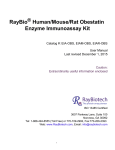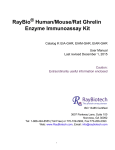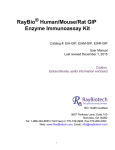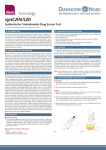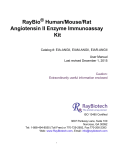Download Manual - RayBiotech, Inc.
Transcript
RayBio® Human/Mouse/Rat Gastrin-1 Enzyme Immunoassay Kit Catalog #: EIA-GAS, EIAM-GAS, EIAR-GAS User Manual Last revised December 1, 2015 Caution: Extraordinarily useful information enclosed ISO 13485 Certified 3607 Parkway Lane, Suite 100 Norcross, GA 30092 Tel: 1-888-494-8555 (Toll Free) or 770-729-2992, Fax:770-206-2393 Web: www.RayBiotech.com, Email: [email protected] 1 Table of Contents Section Page # I. Introduction 3 II. General Description 4 III. How It Works 5 IV. Storage 6 V. Reagents 6 VI. Additional Materials Required 7 VII. Reagent Preparation A. Preparation of Plate and Anti-Gastrin-1 Antibody B. Preparation of Biotinylated Peptide (Item F) C. Preparation of Standards D. Preparation of Positive Control E. Preparation of Samples F. Preparation of Wash Buffer and HRP-Strep 7 7 8 9 10 10 11 VIII. Assay Procedure 11 IX. Assay Procedure Summary 12 X. Calculation of Results A. Typical Data B. Sensitivity C. Detection Range D. Reproducibility E. Assay Diagram 5 13 13 13 13 14 XI. Specificity 14 XII. Select Publications 14 XIII. Troubleshooting Guide 15 Please read the entire manual carefully before starting your experiment 2 I. Introduction Gastrin is a hormone that stimulates secretion of gastric acid by the parietal cells of the stomach and aids in gastric motility. It is released by G cells in the stomach, duodenum, and the pancreas. Gastrin is a linear peptide that is synthesized as a preprohormone and posttranslationally cleaved to form a family of peptides with identical carboxytermini. The predominant circulating form is gastrin-34 (a.k.a. "big gastrin"), but full biologic activity is present in the smaller peptides, i.e., gastrin-17 (a.k.a. "little gastrin") and gastrin-14 (a.k.a. "minigastrin"). In addition, pentagastrin is an artificial 5-amino-acid peptide identical to the carboxyterminus of gastrin. It is worth noting that the five Cterminal amino acids of gastrin and cholecystokinin are identical, which explains their overlapping biological effects. Gastrin is released in response to certain stimuli including stomach distension, vagal stimulation, hypercalcemia and the presence of partially digested proteins. On the other hand, gastrin release can be inhibited by the presence of gastric acid or inhibitory hormones such as secretin, GIP, VIP, glucagon and calcitonin. As a peptide hormone in GI system, gastrin stimulates gastric acid secretion from parietal cells of the stomach. Additional functions by gastrin include the following, Stimulating parietal cell maturation and fundal growth; Causing chief cells to secrete pepsinogen; Increasing antral muscle mobility and promoting stomach contractions; Strengthening antral contractions against the pylorus, and constricting the pyloric sphincter to slow gastric emptying; inducing pancreatic secretions and gallbladder emptying. 3 The role of gastrin in certain diseases has also been reported, including ZollingerEllison Syndrome, autoimmune gastritis and mucolipidosis. In Zollinger-Ellison syndrome, gastrin is produced at excessive levels, often by a gastrinoma of the duodenum or the pancreas. In autoimmune gastritis, the immune system attacks the parietal cells leading to hypochlorhydria. This results in an elevated gastrin level in an attempt to compensate for increased pH in the stomach. Eventually, all the parietal cells are lost and achlorhydria results leading to a loss of negative feedback on gastrin secretion. Plasma gastrin concentration is elevated in virtually all individuals with mucolipidosis type IV secondary to a constitutive achlorhydria. II. General Description The RayBio® Gastrin-1 Enzyme Immunoassay (EIA) Kit is an in vitro quantitative assay for detecting Gastrin-1 peptide based on the competitive enzyme immunoassay principle. In this assay, a biotinylated Gastrin-1 peptide is spiked into the samples and standards. The samples and standards are then added to the plate, where the biotinylated Gastrin-1 peptide competes with endogenous (unlabeled) Gastrin-1 for binding to the anti-Gastrin-1 antibody. After a wash step, any bound biotinylated Gastrin-1 then interacts with horseradish peroxidase (HRP)-streptavidin, which catalyzes a color development reaction. The intensity of the colorimetric signal is directly proportional to the amount of captured biotinylated Gastrin-1 peptide and inversely proportional to the amount of endogenous Gastrin-1 in the standard or samples. A standard curve of known concentration of Gastrin-1 peptide can be established and the concentration of Gastrin-1 peptide in the samples can be calculated accordingly. 4 III. How It Works 5 IV. Storage The entire kit may be stored at -20°C to -80°C for up to 6 months from the date of shipment. For extended storage, it is recommended to store at -80°C. Avoid repeated freeze-thaw cycles. For prepared reagent storage, see table below. V. Reagents Component Size / Description Storage / Stability After Preparation Gastrin-1 Microplate (Item A) 96 wells (12 strips x 8 wells) coated with secondary antibody. 1 month at 4°C* Wash Buffer Concentrate (20X) (Item B) 25 ml of 20X concentrated solution. 1 month at 4°C Standard Gastrin-1 Peptide (Item C) 2 vials of Gastrin-1 Peptide. 1 vial is enough to run each standard in duplicate. The first standard: 2-3 days at 4°C Additional dilutions: Do not store Anti-Gastrin-1 Polyclonal Antibody (Item N) 2 vials of anti-Gastrin-1. 1 month at 4°C Assay Diluent A (Item D) 30 ml, contains 0.09% sodium azide as preservative. Diluent for standards and serum or plasma. N/A Assay Diluent B (Item E) 15 ml of 5X concentrated buffer. Diluent for standards, cell culture media or other sample types, and HRP-Streptavidin. 1 month at 4°C Biotinylated Gastrin-1 Peptide (Item F) 2 vials of Biotinylated Gastrin-1 Peptide, 1 vial is enough to assay the whole plate. 2-3 days at 4°C HRP-Streptavidin Concentrate (Item G) 600 µl 200X concentrated HRP-conjugated streptavidin. Do not store and reuse Positive Control (Item M) 1 vial of Positive Control. 2-3 days at 4°C TMB One-Step Substrate Reagent (Item H) 12 ml of 3,3,5,5'-tetramethylbenzidine (TMB) in buffer solution. N/A Stop Solution (Item I) 8 ml of 0.2 M sulfuric acid. N/A *Return unused wells to the pouch containing desiccant pack, reseal along entire edge. 6 VI. Additional Materials Required 1. 2. 3. 4. 5. 6. 7. 8. 9. 10. 11. Microplate reader capable of measuring absorbance at 450 nm Precision pipettes to deliver 2 µl to 1 ml volumes Adjustable 1-25 ml pipettes for reagent preparation 100 ml and 1 liter graduated cylinders Absorbent paper Distilled or deionized water SigmaPlot software (or other software which can perform four-parameter logistic regression models) Tubes to prepare standard or sample dilutions Orbital shaker Aluminum foil Plastic wrap VII. Reagent Preparation Keep kit reagents on ice during reagent preparation steps. Note: Assay Diluent A should be used for dilution of samples, Item F and Item C when testing plasma or serum samples. 1X Assay Diluent B should be used for dilution of samples, Item F and Item C when testing cell culture media or other sample types. A. Preparation of Plate and Anti-Gastrin-1 Antibody 1. Equilibrate plate to room temperature before opening the sealed pouch. 2. Label removable 8-well strips as appropriate for your experiment. 3. 5X Assay Diluent B (Item E) should be diluted 5-fold with deionized or distilled water. 4. Briefly centrifuge the anti-Gastrin-1 antibody vial (Item N) Then add 50 µl of 1X Assay Diluent B to the vial to prepare the antibody concentrate. Pipette up and down to mix gently. 5. The antibody concentrate should then be diluted 100-fold with 1X Assay Diluent B. This is your anti-Gastrin-1 antibody working solution, which will be used in step 2 of Assay Procedure (Section VIII). 7 Note: The following steps may be done during the antibody incubation procedure (step 2 of Assay Procedure) B. Preparation of Biotinylated Gastrin-1 (Item F) 5. Briefly centrifuge the vial of Biotinylated Gastrin-1 (Item F) before use. 6. See the image below for proper preparation of Item F. Transfer the entire contents of the Item F vial into a tube containing 10 ml of the appropriate Assay Diluent. This is your Working Stock of Item F. Pipette up and down to mix gently. The final concentration of biotinylated Gastrin-1 will be 20 pg/ml. a. Second Dilution of Item F for Standards: Add 2 ml of Working Stock Item F to 2 ml of the appropriate Assay Diluent. The final concentration of biotinylated Gastrin-1 will be 10 pg/ml. b. Second Dilution of Item F for Positive Control: Add 100 µl of Working Stock Item F to 100 µl of the prepared Positive Control (Item M). (See section D for Positive Control preparation) The final concentration of biotinylated Gastrin-1 will be 10 pg/ml. c. Second Dilution of Item F for samples: Add 125 µl of Working Stock Item F to 125 µl of prepared sample (see section E for sample preparation). This is a 2-fold dilution of your sample. The final concentration of biotinylated Gastrin-1 will be 10 pg/ml. 8 C. Preparation of Standards 7. Label 6 microtubes with the following concentrations: 1000 pg/ml, 100 pg/ml, 10 pg/ml, 1 pg/ml, 0.1 pg/ml and 0 pg/ml. Pipette 450 µl of biotinylated Gastrin1 Item F working solution (prepapred in step 6a) into each tube, except the 1,000 pg/ml (leave this one empty). It is very important to make sure the concentration of biotinylated Gastrin-1 is 10 pg/ml in all standards. 8. Briefly centrifuge the vial of Gastrin-1 Standard (Item C). Pipette 8 µl of Item C and 792 µl of 10 pg/ml biotinylated Gastrin-1 working solution (prepared in step 6a) into the tube labeled 1000 pg/ml. Mix thoroughly. This solution serves as the first standard (1000 pg/ml Gastrin-1 standard, 10 pg/ml biotinylated Gastrin1). 9. To make the 100 pg/ml standard, pipette 50 µl of the 1000 pg/ml Gastrin-1 standard into the tube labeled 100 pg/ml. Mix thoroughly. 10. Repeat this step with each successive concentration, preparing a dilution series as shown in the illustration below. Each time, use 450 µl of biotinylated Gastrin-1 and 50 µl of the prior concentration until the 0.1 pg/ml is reached. Mix each tube thoroughly before the next transfer. 9 D. Positive Control Preparation 11. Briefly centrifuge the Positive Control vial (Item M). 12. Refer to step 6b. This is a 2-fold dilution of the Positive Control. The final concentration of biotinylated Gastrin-1 should still be 10 pg/ml. The Positive Control is a cell culture media sample that serves as a system control to verify that the kit components are working. The resulting OD will not be used in any calculations; if no positive competition is observed please contact RayBiotech Technical Support. The Positive Control may be diluted further if desired, but be sure the final concentration of biotinylated Gastrin-1 is 10 pg/ml. E. Sample Preparation 13. If you wish to perform a 2-fold dilution of your sample, proceed to step 6c. If you wish to perform a higher dilution of your sample, dilute your sample with the appropriate Assay Diluent before performing step 6c. EXAMPLE (to make a 4-fold dilution of sample): a. Dilute sample 2-fold (62.5 µl of sample + 62.5 µl of the appropriate Assay Diluent.). b. Perform step 6c (125 µl of working solution Item F + 125 µl of sample prepared above). The total volume is 250 µl, enough for duplicate wells on the microplate. It is very important to make sure the final concentration of the biotinylated Gastrin-1 is 10 pg/ml. Note: Optimal sample dilution factors should be determined empirically, however you may reference below for recommended dilution factors for serum: Human=2X Mouse=2X Rat=2X. If you have any questions regarding the recommendended dilutions you may contact technical support at 888-494-8555 or [email protected]. 10 F. Preparation of Wash Buffer and HRP 14. If Item B (20X Wash Concentrate) contains visible crystals, warm to room temperature and mix gently until dissolved. 15. Dilute 20 ml of Wash Buffer Concentrate into deionized or distilled water to yield 400 ml of 1X Wash Buffer. 16. Briefly centrifuge the HRP-Streptavidin vial (Item G) before use. 17. Dilute the HRP-Streptavidin concentrate 200-fold with 1X Assay Diluent B. Note: do not use Assay Diluent A for HRP-Streptavidin preparation in step 17 VIII. Assay Procedure 1. Keep kit reagents on ice during reagent preparation steps. It is recommended that all standards and samples be run at least in duplicate. 2. Add 100 µl of Anti-Gastrin-1 Antibody (Item N) (See Reagent Preparation step 3) to each well. Incubate for 1.5 hours at room temperature with gentle shaking (1-2 cycle/sec). You may also incubate overnight at 4ºC. 3. Discard the solution and wash wells 4 times with 1X Wash Solution Buffer (200300 µl each). Washing may be done with a multichannel pipette or an automated plate washer. Complete removal of liquid at each step is essential to good assay performance. After the last wash, remove any remaining Wash Buffer by aspirating or decanting. Invert the plate and blot it against clean paper towels. 4. Add 100 µl of each standard (see Reagent Preparation Section C), Positive Control (see Reagent Preparation Section D) and sample (see Reagent Preparation Section E) in appropriate wells. Be sure to include a blank well (Assay Diluent only). Cover wells and incubate for 2.5 hours at room temperature with gentle shaking (1-2 cycles/sec) overnight or at 4ºC. 5. Discard the solution and wash 4 times as directed in Step 3. 6. Add 100 µl of prepared HRP-Streptavidin solution (see Reagent Preparation step 7) to each well. Incubate for 45 minutes at room temperature with gentle 11 shaking. It is recommended that incubation time should not be shorter or longer than 45 minutes. 7. Discard the solution and wash 4 times as directed in Step 3. 8. Add 100 µl of TMB One-Step Substrate Reagent (Item H) to each well. Incubate for 30 minutes at room temperature in the dark with gentle shaking (1-2 cycles/sec). 9. Add 50 µl of Stop Solution (Item I) to each well. Read at 450 nm immediately. IX. Assay Procedure Summary 1. Prepare all reagents, samples and standards as instructed. 2. Add 100 µl anti-Gastrin-1 to each well. Incubate 1.5 hours at room temperature or overnight at 4ºC. 3. Add 100 µl standard or sample to each well. Incubate 2.5 hours at room temperature or overnight at 4ºC. 4. Add 100 µl prepared Streptavidin solution. Incubate 45 minutes at room temperature. 5. Add 100 µl TMB One-Step Substrate Reagent to each well. Incubate 30 minutes at room temperature. 6. Add 50 µl Stop Solution to each well. Read at 450 nm immediately. 12 X. Calculation of Results Calculate the mean absorbance for each set of duplicate stands, controls, and samples and subtract the blank optical density. Plot the standard curve using SigmaPlot software (or other software which can perform four-parameter logistic regression models), with standard concentration on the x-axis and percentage of absorbance (see calculation below) on the y-axis. Draw the best-fit curve through the standard points. Percentage absorbance = (B-blank OD)/B 0-blank OD) where B = OD of sample or standard and B0 = OD of zero standard (total binding) A. Typical Data These standard curves are for demonstration only. A standard curve must be run with each assay. B. Sensitivity The minimum detectable concentrations of Gastrin-1 is 9.92 pg/ml. C. Detection Range 0.1-1,000 pg/ml D. Reproducibility Intra-Assay: CV<10% Inter-Assay: CV<15% 13 E. Assay Diagram Recommended Plate Layout: Key: Blank = Buffer Only Total Binding = Biotin-Gastrin-1 only Standard 1 = 1000 pg/ml Standard 2 = 100 pg/ml Standard 3 = 10 pg/ml Standard 4 = 1 pg/ml Standard 5 = 0.1 pg/ml Pos Control = Biotin with Item M XI. Specificity Cross Reactivity: This EIA kit shows no cross-reactivity with any of the cytokines tested: Ghrelin, Nesfatin, Angiotensin II, NPY and APC. XIV. Publications Citing This Product 1. Singh PK., Hota D., Dutta P., et al. Pantoprazole improves glycemic control in type 2 diabetes: a randomized, double-blind, placebo-controlled trial. J Clin Endocrinol Metab. 2012 Nov;97(11):E2105-8. doi: 10.1210/jc.2012-1720 Species: Human Sample Type: Plasma 14 XIII. Troubleshooting Guide Problem Cause Solution Inaccurate pipetting Improper standard dilution Check pipettes Briefly centrifuge Item C and dissolve the powder thoroughly by gently mixing Low signal Improper preparation of standard and/or biotinylated antibody Too brief incubation times Inadequate reagent volumes or improper dilution Briefly spin down vials before opening. Dissolve the powder thoroughly. Ensure sufficient incubation time; assay procedure step 2 may be done overnight Check pipettes and ensure correct preparation Large CV Inaccurate pipetting Air bubbles in wells Check pipettes Remove bubbles in wells High background Plate is insufficiently washed Contaminated wash buffer Review the manual for proper wash. If using a plate washer, ensure that all ports are unobstructed. Make fresh wash buffer Improper storage of the ELISA kit Stop solution Follow storage recomendations in sections IV and V. Keep substrate solution protected from light. Add stop solution to each well before reading plate Poor standard curve Low sensitivity 15 RayBio® ELISA Kits Over 2,000 ELISA kits available, visit www.RayBiotech.com/ELISA-Kits.html for details. This product is for research use only. ©2015 RayBiotech, Inc 16
















